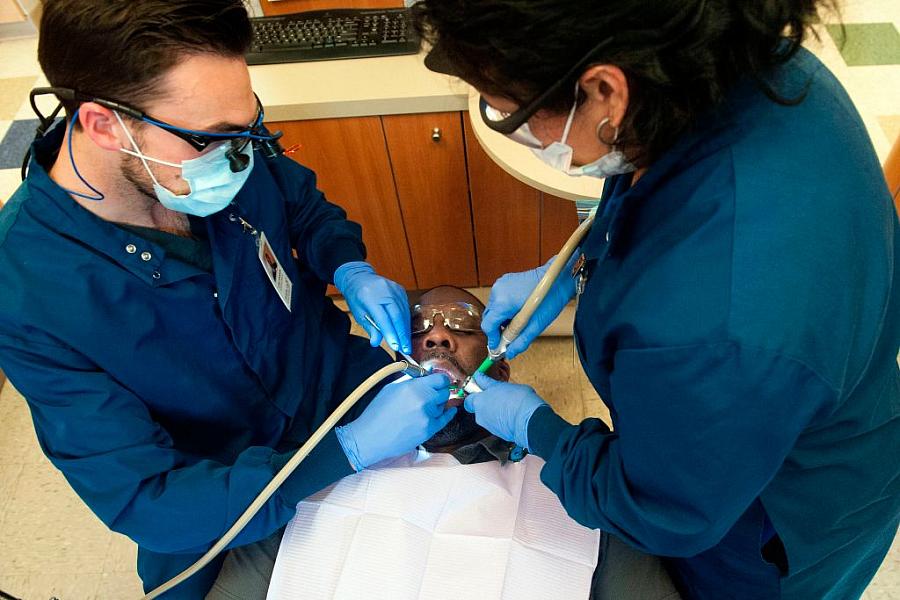Health workforce commissioner: Go beyond doctor-centric stories

Dr. Luke Johnson (L) and dental assistant Rita Garcia treat patient Phillip Malone at Inner City Health Center in Denver, Colorado on March 15, 2017. Photo credit: JASON CONNOLLY/AFP/Getty Images
$39.95. That figure offers a clue to a health story that many reporters are missing, said Dr. David Carlisle, the President and CEO of Charles R. Drew University of Medicine and Science.
If you have a bad tooth in South Central Los Angeles, that’s the advertised price of a cure: a tooth extraction. But head 15 miles over to West Los Angeles, and no one extracts teeth.
“It’s a considered a failure of dental care to have to extract a tooth,” he said. “That’s the difference: extraction vs. repair. But it receives no coverage from the media.”
Carlisle, an expert on health disparities, is one of two dozen members of the new California Future Health Workforce Commission, which will create a master plan to address California’s growing health care workforce shortages. As these challenges receive more media attention, Carlisle urged health reporters to look beyond doctors.
“We tend to be very physician centric in the way we do workforce issues,” he said. “This is a much bigger issue.”
Expand Interview Subjects
Instead of strictly asking about medical providers, Carlisle urged reporters to examine the availability and diversity of dentists, psychologists, pharmacists and optometrists in their community.
“As challenged as the medical side of health professions is, those other professions are probably more challenged in terms of workforce distribution and diversity, but they don’t receive the same attention that they need to,” he said.
I asked Carlisle whether new medical schools such as the Kaiser medical school in Southern California was a step in the right direction for expanding the health workforce. While he agreed it was, he also challenged me to ask why there are not new dental schools or psychology programs.
To unearth better health care workforce stories, he said, reporters should cross off “physician” and replace it with “dentist, psychologist, pharmacist or optometrist.” Call the dean of these programs and ask about diversity in their graduates. Ask what school leaders or industry groups have done to address health access problems or patients being unable to afford care. Look at rural areas of California and see how dental or mental health needs are being met. Reporters should also explore where these professionals are located compared to a population’s health care needs.
“These issues are much more acute in these other professions than they are in medicine,” he said. “We pay too short shrift to other health professions.”
Expanding Diversity
That’s not to say physician shortages—especially in primary care—isn’t a major concern, he said. In fact, a UCSF report released last month pointed to the significant shortfall of primary care providers that California will face in the upcoming years.
“The mid-range estimate showed a shortfall of about 4,700 primary care clinicians in 2025 and a need for roughly 4,100 additional providers in 2030 to meet the expected population demand,” according to the report. And uneven distribution will result in acute shortages in places such as the Central Valley, the report also found. (To read more about the physician shortfall in the San Joaquin Valley and its implications, check out Valley Public Radio reporter Kerry Klein’s fellowship project here.)
To address that physician shortage, Carlisle emphasized the importance of mid-level providers such as nurse practitioners who can be produced more quickly than physicians. He also pointed to the importance of training providers from underserved regions who are more likely to return to their communities.
“One does not achieve diversity unless one produces diversity,” he said, adding that diverse admissions to professional programs should be a priority.
During the 15-month commission, Carlisle and fellow members will be working with commission co-chairs Janet Napolitano, president of the University of California, and Lloyd Dean, the president/CEO of Dignity Health. Along with addressing how to bolster the overall health workforce, the commission will emphasize primary care, behavioral health and care for the elderly.
The workforce commission’s website has insightful statistics that could also lead to workforce article ideas such as:
- Even though 38 percent of the state’s population is Latino, only seven percent of physicians are Latino.
- Four of the ten counties in California with the most “mental distress” don’t have any psychiatrists.
- An indication of the aging population: Personal care aides who help people with physical and cognitive disabilities, will likely see more job growth than any other professions in the state.

